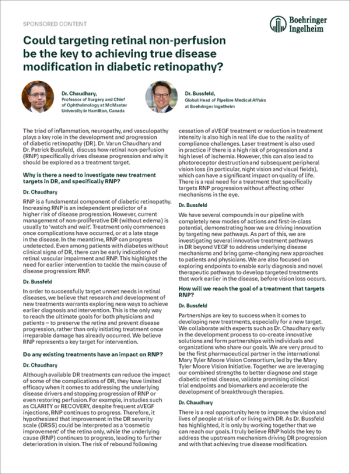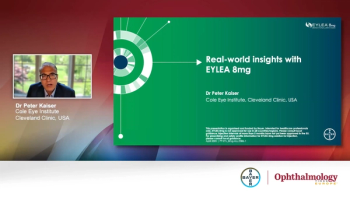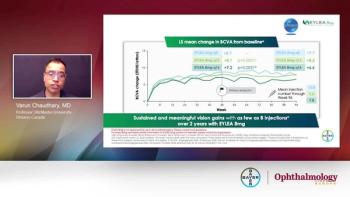
Propelling R&D for Novel Retinal Therapies Through Innovative Clinical Trial Design
Brought to you by:
Due to the changing regulatory landscape, developing and distinguishing new investigational products from approved treatment options is challenging. That is why advances in treatments, especially in retinal therapies, often must spark change to how clinical trials are designed and conducted.
The design of pivotal studies in the treatment of retinal diseases with therapies that extend the treatment intervals have become more challenging because the FDA does not consider a reduction in the number of injections as a significant improvement over existing therapy. This article reviews innovative approaches to pivotal study design based on experience from Ocular Therapeutix’s (“Ocular”) wet age-related macular degeneration (wet AMD) registration program.*
Masking treatments with different schedules – without sham procedures
Clinical trials in retinal diseases using intravitreal injections that have different dosing schedules compared to the control group have historically used sham procedures for masking purposes.1 Over the last eight years, the U.S. Food and Drug Administration (FDA) highlighted concerns about the adequacy of sham injections to maintain masking.2 In a 2017 clinical review, FDA reviewers noted that “patients can often tell that they are receiving a sham injection instead of an actual injection,” which may indicate ineffective masking.2 The current draft guidance for developing drugs for wet AMD does not prohibit the use of sham injections, however, it is possible that the Agency may raise regulatory questions at the time of NDA submission, for studies that utilized a sham control strategy.3,4
In designing the
Generating complementary evidence versus replicating results
Achieving the evidence standard for FDA approval typically requires two adequately controlled clinical trials. The trials do not have to be called Phase 3 trials as many Phase 2 trials are performed meeting all the regulatory requirements to serve as one of the required trials. In rare diseases sometimes a single trial may suffice. In general, the two pivotal trials are designed identically and performed in parallel at different clinical sites.7 The benefit of this approach is that it can provide substantial evidence of the replicability of each trials’ findings.7 However, the FDA’s guidance also states this approach of precise replication is only one of many possible means of substantiating clinical findings.7 The FDA’s guidance for Demonstrating Substantial Evidence of Effectiveness for Human Drug and Biological Products notes that two trials with differences in design and conduct may, in some respects, be more persuasive.7
This thinking is what informed Ocular’s approach to the SOL pivotal trial program for OTX-TKI in wet AMD.
Rather than replicating this finding with an identical trial, the Ocular team sought to instead generate data that both substantiates and is complementary to SOL-1. This rationale informed the design and protocol for SOL-R, a non-inferiority study evaluating repeat dosing of OTX-TKI every Q6M compared to 2 mg aflibercept, dosed every 8 weeks. Importantly, this trial was designed to mimic “real-world” clinical care and provide commercially relevant data.
Together the studies are intentionally designed to provide physicians with important evidence on the durability, repeatability and flexibility of OTX-TKI and the potential for re-dosing every six to twelve months.
Enhancing confidence through regulatory alignment
The clinical design of both SOL clinical trials has been closely coordinated with the FDA to help de-risk both the clinical trial design and regulatory pathway. In the case of SOL-1, Ocular received written agreement from the FDA regarding the overall design under a Special Protocol Assessment (SPA). The SPA provides clarity and regulatory alignment that the FDA agreed the protocol was adequate to support a New Drug Application (NDA).
A SPA is valuable for clinical trials with complex designs but also is limiting since changes in the protocol will require a SPA amendment, which may or may not be accepted by the FDA. The extensive background and experience of the Ocular team, allowed us to proactively engage the FDA and achieve alignment for the SOL-1 SPA amendment to allow repeat dosing in year 2 with adequate masking to be added to the protocol.8
For SOL-R, Ocular coordinated closely with the FDA resulting in a Type C response, and a subsequent written response, that agreed the SOL-R protocol should be appropriate for use as Ocular’s second adequate and well-controlled study to support a potential NDA and product label for wet AMD. Through both the SPA and written responses, Ocular increased overall confidence in the quality of evidence being generated in the SOL clinical program through close collaboration with the FDA, helping de-risk the regulatory pathway for OTX-TKI.9
++
Lessons from the ongoing SOL program highlight how innovative trial designs can advance and evolve clinical trials to better define outcomes and durability of potential future treatments. Similarly, innovative trial protocols benefit from alignment with regulators to ensure these protocols are executed in a manner that minimizes bias and may de-risk the regulatory pathway for potential new treatments, while remaining scientifically robust and approvable. Finally, clinical trials should also help physicians understand the best use of any new treatment for their patients.
As the therapeutic landscape grows increasingly complex, evolving clinical trial methodologies should do more than support regulatory approval – they should also equip physicians with a data-driven roadmap that offers applicability in day-to-day clinical practice. The integration of innovative trial designs holds the potential to generate not only approvable evidence, but actionable insights that may redefine future standards of care.
++
*As of publication on July 2025 the SOL clinical trials in wet age-related macular degeneration are ongoing and OTX-TKI is an investigational product that has not been approved by the FDA or any other Health Authority.
References:
- Glassman A, et al. Arch Ophthalmol. 2012;130(2):190-4.
- Lim L, Center for Drug Evaluation and Research. Clinical Review BLA 761235.
https://www.accessdata.fda.gov/drugsatfda_docs/nda/2022/761235Orig1s000MedR.pdf . Published September, 2017. Accessed May 28, 2025. - Center for Biologics Evaluation and Research. Human Gene Therapy for Retinal Disorder. Guidance for Industry.
https://www.fda.gov/media/124641/download . Published January, 2020. Accessed May 28, 2025. - Center for Biologics Evaluation and Research, Center for Drug Evaluation and Research. Neovascular Age-Related Macular Degeneration: Developing Drugs for Treatment. Draft Guidance for Industry.
https://www.fda.gov/media/165606/download . Published February, 2023. Accessed June 10, 2025. - EYLEA [prescribing information]. Tarrytown, NY: Regeneron; 2024.
- Ramos MS, et al. Ophthalmol Retina. 2021;5(7):625632.
- Center for Biologics Evaluation and Research, Center for Drug Evaluation and Research. Demonstrating Substantial Evidence of Effectiveness for Human Drug and Biological Products. Draft Guidance for Industry.
https://www.fda.gov/media/133660/download . Published December, 2019. Accessed May 28, 2025. - Ocular Therapeutix™ Reports Fourth Quarter and Full Year 2024 Results and Business Highlights. Press release. Published March 3, 2025.
https://investors.ocutx.com/news-releases/news-release-details/ocular-therapeutixtm-reports-fourth-quarter-and-full-year-2024 . - Center for Biologics Evaluation and Research, Center for Drug Evaluation and Research. Formal Meetings Between the FDA and Sponsors or Applicants of PDUFA Products. Draft Guidance for Industry.
https://www.fda.gov/media/172311/download . Published September, 2023. Accessed May 28, 2025.
Newsletter
Keep your retina practice on the forefront—subscribe for expert analysis and emerging trends in retinal disease management.








































